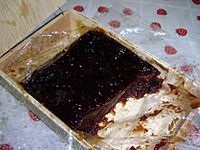Goiabada facts for kids

Commercially produced Goiabada
|
|
| Alternative names | Guava paste, guava cheese |
|---|---|
| Type | Jam |
| Place of origin | Brazil |
| Region or state | Americas, Goa (India) |
| Main ingredients | Guava, sugar, water |
Goiabada (pronounced go-yah-BAH-dah) is a sweet treat from Brazil. It's a type of fruit paste or conserve made from red guavas and sugar. You can find it in many countries where Portuguese is spoken.
This yummy dessert has a long history. It first appeared during the time when Brazil was a colony. People used guavas instead of quinces, which were used to make a similar sweet called marmelada. Making goiabada needed a lot of sugar and was cooked slowly in big pots. Even today, many families in Brazil's countryside still make it at home. It can also be bought from small local businesses or as a processed food. Goiabada usually has a deep, slightly bluish-red color.
Contents
What is Goiabada?
Goiabada is a thick, sweet paste made from guavas. It's like a very firm jam. The main ingredients are fresh red guavas, sugar, and water. The mixture is cooked down until it becomes very thick and can be sliced. It's a popular dessert and snack in Brazil and other Portuguese-speaking places.
Similar Sweets Around the World
Goiabada is quite similar to a sweet from Colombia called bocadillo. Bocadillo is also made from guava but often has even more sugar.
In English-speaking countries, especially in the Caribbean, goiabada is known as guava paste or guava cheese. In Spanish-speaking countries, it has names like dulce de guayaba, barra de guayaba, pasta de guayaba, bocadillo or guayabate. In Goa (India), which used to be a Portuguese colony, it's called perad. You can often buy goiabada in flat metal cans or in rectangular blocks inside cardboard boxes.
How to Enjoy Goiabada
In Brazil, a very popular way to eat goiabada is with Minas cheese. This delicious combination is so famous that people call it "Romeo and Juliet." It's a sweet and savory pairing that many Brazilians love.
Goiabada is also great spread on toast for breakfast. In Portugal, it's used as a filling for a popular cake called bolo de rosas (rose cake). This cake has a layer of pastry covered with goiabada, then rolled up and cut into pieces that look like roses.
In Brazil, a similar rolled cake is called rocambole. It's like a Swiss roll with a layer of goiabada inside. Another well-loved dessert that uses goiabada is the bolo de rolo.
Different Textures of Goiabada
Goiabada can come in many different textures. Some types are very soft, like a thin paste. You can eat these with a spoon or spread them on bread or cakes. Other types are very hard, like a solid block, and you might need a knife to slice them.
The goiabada you buy in cans is usually somewhere in the middle. It's firm enough to be cut into slices but still soft. The texture depends on the type of guava used, how much sugar is added, the amount of water, and how long it's cooked.
See also
 In Spanish: Goiabada para niños
In Spanish: Goiabada para niños


